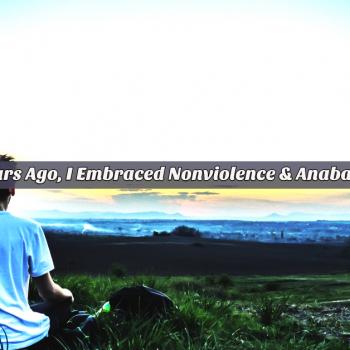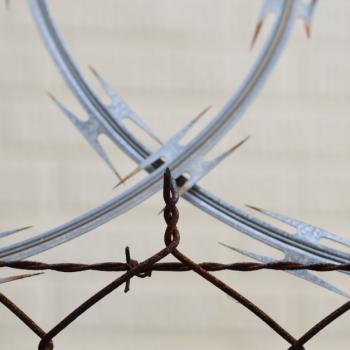The following is part of a fairly long series on the theology and practice of nonviolence. If you would like to read all of the posts, you can do so here.
————————————–
The Shirt off Your Back, and then Some!
This second scenario envisions a situation where a creditor takes a poor person to court to sue them for their shirt. This could be kept as collateral for an unpaid debt, but the coat (cloak) was not to be taken according to Mosaic Law (Ex. 22.25-27; Deut. 24.12-13). A coat (which in a Jewish context would be the only other piece of clothing worn by most people) would not be taken away on humanitarian grounds as it could be used to keep warm, especially at night.[1]
Debt in antiquity under Roman taxation policy was inevitable for common people. Not only did the emperor demand payment from corrupt tax collectors who would take whatever they wanted off the top, but the rich would do whatever they could to gain control of generational property – often owned by poor Galileans. Therefore, the rich charged anywhere from 25-200 percent interest on various ventures, eventually driving them out of their property and leaving the poor person with a large sum of debt.
This situation in the lawcourt presumes that the worst-case scenario has been reached; the only thing worth suing for is the shirt off one’s back! But luckily, the person being sued knows that the coat cannot be taken by force. So, what does Jesus instruct debtor do? He tells such a person not only to give the shirt as payment but to relinquish the coat as well. In doing so, it is not the debtor that would be shamed by the nakedness, but the creditor. This is because in the Hebraic culture it was shameful for the person viewing the nudity, rather than for the naked party (see Genesis 9.20-27). If a person walks out of the courtroom naked, the creditor has not only been stricken with shame because of injustice, but has transferred such to all who will see the debtor without dress. This debtor has now exposed the evils of an unjust debt and tax system, and of the creditor who sued in the first place. Rather than live powerlessly or resort to violent revolution, the oppressed can expose the cruelty of the system by shaming it publicly.[2]
Just One Mile – and No Further
It is commonly known that in the first century Roman soldiers had the right to force a subjugated person to carry his equipment for up to one mile. Law mandated that such soldiers could not have someone carry anything beyond that measure. Imagine being such a person. What about the work that you need to get done simply to survive, and now this arrogant soldier demands that you do his work for him? Jesus’ instructions for the peasant to go the second mile is absurd by first century standards. This impoverished Jewish person who is being taken advantage of has now turned the tables. How will the soldier respond to this Jewish peasant that keeps walking? And, what is the point of going the second mile in the first place? Well, to go a second mile could potentially get the soldier into trouble with his commanding officer, the centurion. Punishment for this extra mile of injustice may include being fined, having food rationed, flogging, or a reprimand; nevertheless, the soldier would be scared of the potential consequences. He may even beg the subversive Jew to put down the pack… what a hilarious scene that could have been! In such a scenario, the powerless have seized the upper hand in the situation and forced their persecutors to recognize the inhumanity of their ways.[3]
In the above predicament a person chooses to be creative over against retaliation. A policy that was used to remind Jews of their subjugation has been subverted to demonstrate their human dignity. Jesus offers a renewed approach to living fully human, one that refuses to join violent revolution movements, to follow a radical revolutionary on a road to the cross.[4]
Love your Enemies
All of the above examples of nonviolent resistance must be rooted in love for enemies (v. 44). This is not a love for only God, but a love for the very people who inflict both physical and social pain. One may wonder if the above examples are actually loving, for they seem to be quite confrontational. But if Jesus is indeed our model for what love looks like, then we must recognize that “his concept of love is apparently not at the level of simply being nice to people and of allowing error to go unchallenged.”[5] Rather, his love for his enemies, such as the scribes and Pharisees, was not without rebuke. So in the cases of the turned cheek, the naked man, and the extra mile, there is indeed the infusion of love for the enemy. This is because “Jesus is not advocating nonviolence merely as a technique for outwitting the enemy, but as a just means of opposing the enemy in a way that holds open the possibility of the enemy’s becoming just also.”[6] In other words, this kind of love extends the possibility of an enemy discovering his or her sin, thus repenting and becoming a friend. But even if this kind of best-case scenario does not come to fruition, one will not have resorted to the pattern of violence that oppressive systems of empire employ. Rather, the one being oppressed has risen above injustice. This is nonviolent resistance.[7]
PS – How do you love someone and shoot them? My answer… it is impossible! (More on the practical questions coming soon!)
[1]. France, The Gospel of Matthew, 221.
[2]. Wink, The Powers That Be: Theology for a New Millennium, 103-5.
[3]. Ibid., 106-8.
[4]. Tom Wright, Matthew for Everyone, 1 (Louisville, KY: Westminster John Knox Press, 2004), 52.
[5]. France, The Gospel of Matthew, 226.
[6]. Wink, The Powers That Be: Theology for a New Millennium, 110.
[7]. Ibid., 110-11.












